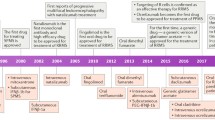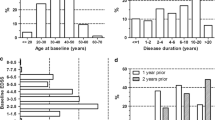Abstract
The results on relapse rate and disease progression of available drugs for multiple sclerosis are shown, as well as their most relevant side effects. Results from pivotal and long-term follw-up studies support the efficacy and safety of intererons and glatiramer acetate. The treatment with mitoxantrone is limited by the occurrence of infertility, cardiotoxicy and leukaemia. Efficacy and tolerability of natalizumab are undisputable, compared to other drugs. Risks related to its treatment are PML, opportunistic infections, hepatotoxicity, melanoma, and their occurrence needs to be more exactly assessed by post-marketing surveillance. The principles of induction versus escalating therapy are also discussed. The final therapeutic decision is based on the evaluation of the disease state and prognosis, based on clinical and instrumental measures, and on the safety/efficacy profile of each treatment.
Similar content being viewed by others
References
The IFNB MS Study Group (1993) Interferon beta 1B is effective in relapsing remitting multiple sclerosis. I. Clinical results of a multicenter, randomized, double-blind, placebo-controlled trial. Neurology 43:655–661
Jacobs LD, Cookfair DL, Rudick RA et al (1996) Intramuscular Interferon beta 1a for disease progression in relapsing multiple sclerosis. Ann Neurol 39:285–294
PRISMS (Prevention of Relapses and Disability by Interferon B-1a Subcutaneously in Multiple Sclerosis) Study Group (1998) Randomised double blind placebo-controlled study of interferon β-1a in relapsing-remitting multiple sclerosis. Lancet 352:1498–1504
Johnson KP, Brooks BR, Cohen JA et al (1995) Copolymer 1 reduces relapse rate and improves disability in relapsing-remitting multiple sclerosis: results of the phase III multicenter, double blind, placebo-controlled trial. Neurology 45:1269–1276
Polman CH, O’Connor PW, Havrdova E et al (2006) A randomized, placebo-controlled trial of natalizumab for relapsing multiple sclerosis. N Engl J Med 354:899–910
Rudick RA, Stuart WH, Calabresi PA et al (2006) Natalizumab plus interferon beta-1a for relapsing multiple sclerosis. N Engl J Med 354:911–923
Hartung HP, Gonsette R, Kwiecinski H et al (2002) Mitoxantrone in progressive multiple sclerosis: a placebo-controlled, double-blind, randomized, multicenter trial. Lancet 360:2018–2025
The IFNB Multiple Sclerosis Study Group and The University of British Columbia MS/MRI Analysis Group (1995) Interferon beta-1b in the treatment of multiple sclerosis: final outcome of the randomized controlled trial. Neurology 45:1277–1285
Filippini G, Munari L, Incorvaia B et al (2003) Interferons in relapsing remitting multiple sclerosis: a systematic review. Lancet 361:545–552
Kappos L, Polman CH, Freedman MS et al (2006) Treatment with interferon-1b delays conversion to clinically definite and McDonald MS in patients with clinically isolated syndromes. Neurology 67:1242–1249
The PRISMS Study Group and the University of British Columbia MS/RMI Analysis Group PRISMS-4 (2001) Long-term efficacy of interferon-beta-1a in relapsing MS. Neurology 56:1620
Montalban X. BENEFIT trial results. Presentation at: CONy Second World Congress on Controversies in Neurology, Athens, 25 October, 2008
Millefiorini E, Gasperini C et al (1997) Randomized placebo-controlled trial of mitoxantrone in relapsing-remitting multiple sclerosis: 24 month clinical and MRI outcome. J Neurol 244:153–159
Edan G, Miller D et al (1995) Evaluation of the efficacy of mitoxantrone by use of MRI: a multicenter randomised study in multiple sclerosis. Neurology 242(Suppl 2):S38
Jammohammed R, Milligan DW (1989) Mitoxantrone induced congestive heart failure in patients previously treated with anthracyclines. Br J Haematol 71:292–293
Ghalie RG, Mauch E, Edan G, Hartung HP, Gonsette RE, Eisenmann S et al (2002) A study of therapy-related acute leukaemia after mitoxantrone therapy for multiple sclerosis. Mult Scler 8:441–445
Avasarala JR, Cross AH, Clifford DB, Singer BA, Siegel BA, Abbey EE (2003) Rapid onset mitoxantrone-induced cardiotoxicity in secondary progressive multiple sclerosis. Mult Scler 9:59–62
Paul F, Dorr J, Wurfel J, Vogel HP, Zipp F (2007) Early mitoxantrone-induced cardiotoxicity in secondary progressive multiple sclerosis. J Neurol Neurosurg Psychiatry 78:198–200
Ellis R, Boggild M (2009) Therapy-related acute leukaemia with mitoxantrone: what is the risk and can we minimise it? Mult Scler 15:505–508
Martinelli V, Amato M, Bellantonio P, Bergamaschi R, Bertolotto A, Capra R, Cocco E, Gallo P, Ghezzi A, Pozzilli C, Rodegher M, Straffi L, Trojano M, Comi G (2008) Incidence of acute leukaemia in multiple sclerosis patients treated with mitoxantrone. Neurol Sci 29(Suppl):S75
Simmons DL (2005) Anti-adhesion therapies. Curr Opin Pharmacol 5:398–404
Ropper AH (2006) Selective treatment of multiple sclerosis. N Engl J Med 354:965–967
Yednock TA, Cannon C, Fritz LC, Sanchez-Madrid F et al (1992) Prevention of experimental autoimmune encephalomyelitis by antibodies against alpha 4 beta 1 integrin. Nature 356:63–66
Theien BE, Miller DH, Khan OA, Sheremata WA, Blumhardt LD, Rice GP, Libonati MA, Willmer-Hulme AJ, Dalton CM, Miszkiel KA, O’Connor PW (2003) A controlled trial of natalizumab for relapsing multiple sclerosis. N Engl J Med 2(348):15–23
Stuve O, Gold R, Chan A, Mix E, Zettl U, Kieseier BC (2008) Alpha4-Integrin antagonism with natalizumab: effects and adverse effects. J Neurol 255(Suppl 6):58–65
EMEA Pressoffice. Hepatotoxicity London 20 March 2008. http://www.emea.europa.eu/pressoffice/chmp.htm
Mullen JT, Vartanian TK, Atkins MB (2008) Melanoma complicating treatment with natalizumab for multiple sclerosis. N Engl J Med 358:647–648
O’Connor P, Filippi M, Arnason B, Comi G, Cook S, Goodin D, Hartung HP, Jeffery D, Kappos L, Boateng F, Filipov V, Groth M, Knappertz V, Kraus C, Pohl C, Sandbrink R, Bogumil T (2009) Interferon beta-1b 250 μg versus interferon beta-1b 500 μg versus glatiramer acetate in relapsing-remitting multiple sclerosis: results of a prospective, randomised multicentre study. Lancet (submitted)
Mikol DD et al (2008) Comparison of subcutaneous interferon beta-1a with glatiramer acetate in patients with relapsing multiple sclerosis (the REbif vs Glatiramer Acetate in Relapsing MS Disease [REGARD] study): a multicentre, randomised, parallel, open-label trial. Lancet Neurol 7:903–914
The results of the EVIDENCE, INCOMIN, and phase III studies of interferon beta products in the treatment of multiple sclerosis. Clin Ther 25:105–118
Multiple Sclerosis Therapy Consensus Group (2008) Basic and escalating immunomodulatory treatments in multiple sclerosis: current recommendations. J Neurol 255:1449–1463
Paul F, Dorr J, Wurfel J, Vogel HP, Zipp F (2007) Early mitoxantrone-induced cardiotoxicity in secondary progressive multiple sclerosis. J Neurol Neurosurg Psychiatry 78:198–200
Ellis R, Boggild M (2009) Therapy-related acute leukaemia with mitoxantrone: what is the risk and can we minimise it? Mult Scler 15:505–508
Simon JH, Jacobs LD, Campion M et al (1998) Magnetic resonance studies of intramuscular interferon β-1a for relapsing multiple sclerosis. Ann Neurol 43:79–87
Galetta SL, Markowitz C, Lee AG (2002) Immunomodulatory agents for the treatment of relapsing multiple sclerosis: a systematic review. Arch Intern Med 162:2161–2169
European Medicines Agency (2005) Rebif European public assessment report (EPAR) scientific discussion. http://www.emea.eu/humandocs/PDFs/EPAR/Rebif/002298en6.pdf. Accessed 1 Aug 2009
Li DKB, Paty DW, The UBC MS/MRI Analysis Research Group, and PRISMS Study Group (1999) Magnetic resonance imaging results of the PRISMS trial: a randomized, double-blind, placebo-controlled study of interferon-β1a in relapsing–remitting multiple sclerosis. Ann Neurol 46:197–206
Paty DW, Li DK (1993) Interferon beta-1b is effective in relapsing–remitting multiple sclerosis. II. MRI analysis results of a multicenter, randomized, double-blind, placebo-controlled trial. UBC MS/MRI Study Group and the IFNB Multiple Sclerosis Study Group. Neurology 43:662–667
Johnson KP, Brooks BR, Cohen J et al (1998) Extended use of glatiramer acetate (Copaxone) is well tolerated and maintains its clinical effect on multiple sclerosis relapse rate and degree of disability. Copolymer 1 Multiple Sclerosis Study Group. Neurology 50:701–708
Comi G, Filippi M, Wolinsky JS, and The European/Canadian Glatiramer Acetate Study Group (2001) European/Canadian multicenter, double-blind, randomized, placebo-controlled study of the effects of glatiramer acetate on magnetic resonance imaging-measured disease activity and burden in patients with relapsing multiple sclerosis. Ann Neurol 49:290–297
Conflict of interest statement
The authors declare that they have no conflict of interest related to the publication of this article.
Author information
Authors and Affiliations
Corresponding author
Rights and permissions
About this article
Cite this article
Comi, G. Treatment of multiple sclerosis: role of natalizumab. Neurol Sci 30 (Suppl 2), 155–158 (2009). https://doi.org/10.1007/s10072-009-0147-2
Published:
Issue Date:
DOI: https://doi.org/10.1007/s10072-009-0147-2




